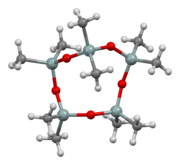
Back دکامتیلسیکلوپنتاسیلوکسان AZB Dekamethylcyklopentasiloxan Czech Decamethylcyclopentasiloxan German Δεκαμεθυλοκυκλοπεντασιλοξάνιο Greek Dekametilziklopentasiloxano Basque دکامتیلسیکلوپنتاسیلوکسان Persian Dekametyylisyklopentasiloksaani Finnish Cyclométicone French Decamethylcyclopentasiloxaan Dutch Декаметилциклопентасилоксан Russian
 | |
 Ball-and-stick model of the molecule as found in the crystal structure determined by single-crystal X-ray diffraction[1]
| |
 Sample of decamethylcyclopentasiloxane
| |
| Names | |
|---|---|
| Preferred IUPAC name
Decamethyl-1,3,5,7,9,2,4,6,8,10-pentaoxapentasilecane | |
Other names
| |
| Identifiers | |
3D model (JSmol)
|
|
| 1800166 | |
| ChEMBL | |
| ChemSpider | |
| DrugBank | |
| ECHA InfoCard | 100.007.969 |
| EC Number |
|
| MeSH | Decamethylcyclopentasiloxane |
PubChem CID
|
|
| RTECS number |
|
| UNII | |
CompTox Dashboard (EPA)
|
|
| |
| |
| Properties | |
| [(CH3)2SiO]5 | |
| Molar mass | 370.770 g·mol−1 |
| Appearance | Colourless liquid |
| Density | 0.958 g/cm3 |
| Melting point | −47 °C; −53 °F; 226 K |
| Boiling point | 210 °C (410 °F; 483 K) |
| 17.03±0.72 ppb (23 °C) [2] | |
| log P | 8.07[3] |
| Vapor pressure | 20.4±1.1 Pa (25 °C) [4] |
| Viscosity | 3.74 cP |
| Hazards | |
| GHS labelling: | |
 
| |
| Warning | |
| H226, H361, H412, H413 | |
| P201, P202, P210, P233, P240, P241, P242, P243, P273, P280, P281, P303+P361+P353, P308+P313, P370+P378, P403+P235, P405, P501 | |
| NFPA 704 (fire diamond) | |
| Flash point | 73 °C (163 °F; 346 K) |
| Safety data sheet (SDS) | External MSDS |
| Related compounds | |
Related Organosilicon compounds
|
Octamethylcyclotetrasiloxane |
Except where otherwise noted, data are given for materials in their standard state (at 25 °C [77 °F], 100 kPa).
| |
Decamethylcyclopentasiloxane, also known as D5 and D5, is an organosilicon compound with the formula [(CH3)2SiO]5. It is a colorless and odorless liquid that is slightly volatile.[5]
- ^ S. Parsons, D. Rankin, P. A. Wood (2004). "CSD Communication YAGTOQ: decamethylpentasilsesquioxane". Cambridge Structural Database: Access Structures. Cambridge Crystallographic Data Centre. doi:10.5517/cc89wzd. Retrieved 2021-08-18.
{{cite journal}}: CS1 maint: multiple names: authors list (link) - ^ Sudarsanan Varaprath; Cecil L. Frye; Jerry Hamelink (1996). "Aqueous solubility of permethylsiloxanes (silicones)". Environmental Toxicology and Chemistry. 15 (8): 1263–1265. Bibcode:1996EnvTC..15.1263V. doi:10.1002/etc.5620150803.
- ^ Shihe Xu, Bruce Kropscott (2012). "Method for Simultaneous Determination of Partition Coefficients for Cyclic Volatile Methylsiloxanes and Dimethylsilanediol". Analytical Chemistry. 84 (4): 1948–1955. doi:10.1021/ac202953t. PMID 22304371.
- ^ Ying Duan Lei; Frank Wania; Dan Mathers (2010). "Temperature-Dependent Vapor Pressure of Selected Cyclic and Linear Polydimethylsiloxane Oligomers". Journal of Chemical & Engineering Data. 55 (12): 5868–5873. doi:10.1021/je100835n.
- ^ Record of Decamethylcyclopentasiloxan in the GESTIS Substance Database of the Institute for Occupational Safety and Health, accessed on 25. September 2015.
